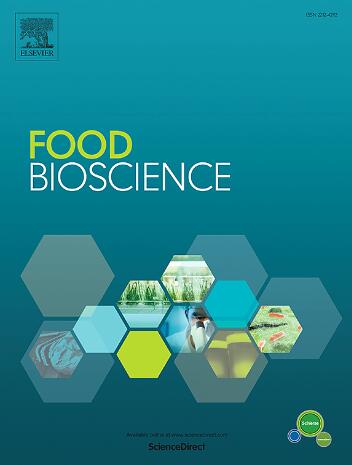非传统霉菌表面接种对干发酵香肠理化及感官特性的影响
IF 4.8
1区 农林科学
Q1 FOOD SCIENCE & TECHNOLOGY
引用次数: 0
摘要
本研究评估了接种米曲霉、卡蒙伯青霉、罗氏青霉和nalgiovense青霉对干腌发酵香肠(salchichón)理化和感官特性的影响。准备了五组香肠:一组作为对照,四组作为对照,每组分别接种了不同的霉菌。在31天的成熟期内分析了微生物生长、理化参数、质地特征和感官属性。结果表明,成熟最后一天的霉菌着床量差异显著,其中石竹和石竹的着床量最高。与对照相比,接种的香肠具有更高的pH值和水分保持性。质构分析表明,接种了nalgiovense的香肠硬度较低。使用Check-All-That-Apply和Rate-All-That-Apply方法的感官评估显示,每个实验组的风味特征都不同,霉菌接种的香肠产生了独特的属性,如奶酪或花香。尽管存在这些差异,但实验组之间的总体可接受性并没有显著差异。这项研究强调了非传统霉菌物种在保持产品安全和质量的同时,创造具有多种感官细微差别的创新型干腌香肠的潜力。本文章由计算机程序翻译,如有差异,请以英文原文为准。

Physicochemical and sensory properties of dry-fermented sausages as influenced by the surface inoculation with non-traditional molds
This study evaluated the impact of inoculating Aspergillus oryzae, Penicillium camemberti, Penicillium roqueforti, and Penicillium nalgiovense on the physicochemical and sensory characteristics of dry-cured fermented sausages ("salchichón"). Five experimental groups of sausages were prepared: one control and four others, each individually inoculated with a different mold species. Microbial growth, physicochemical parameters, texture profile, and sensory attributes were analyzed throughout a 31-day ripening period. Results showed significant differences in mold implantation on the final day of ripening, with P. roqueforti and P. nalgiovense achieving the highest development. Inoculated sausages exhibited higher pH values and moisture retention compared to the control. Texture analysis revealed lower hardness in sausages inoculated with P. nalgiovense. Sensory evaluation using Check-All-That-Apply and Rate-All-That-Apply methods demonstrated distinct flavor profiles for each experimental group, with mold-inoculated sausages developing unique attributes such as cheese or floral notes. Despite these differences, overall acceptability did not significantly vary between experimental groups. This research highlights the potential of non-traditional mold species to create innovative dry-cured sausages with diverse sensory nuances while maintaining product safety and quality.
求助全文
通过发布文献求助,成功后即可免费获取论文全文。
去求助
来源期刊

Food Bioscience
Biochemistry, Genetics and Molecular Biology-Biochemistry
CiteScore
6.40
自引率
5.80%
发文量
671
审稿时长
27 days
期刊介绍:
Food Bioscience is a peer-reviewed journal that aims to provide a forum for recent developments in the field of bio-related food research. The journal focuses on both fundamental and applied research worldwide, with special attention to ethnic and cultural aspects of food bioresearch.
 求助内容:
求助内容: 应助结果提醒方式:
应助结果提醒方式:


